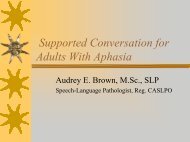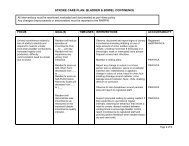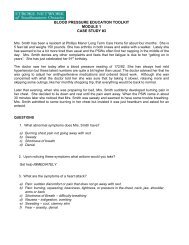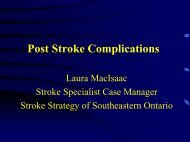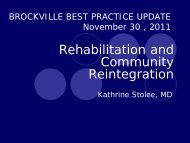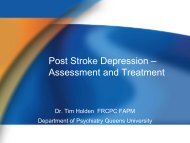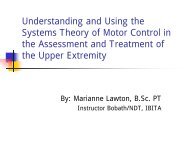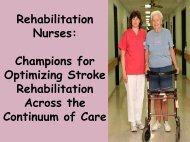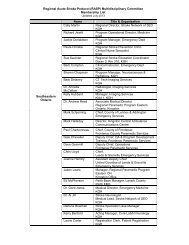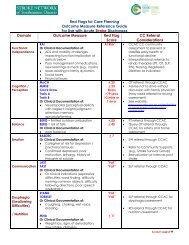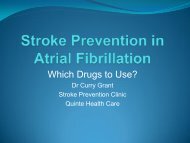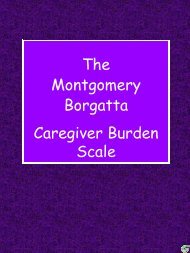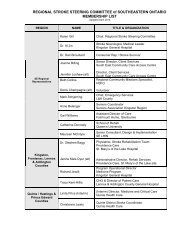SodiuM
SodiuM
SodiuM
Create successful ePaper yourself
Turn your PDF publications into a flip-book with our unique Google optimized e-Paper software.
Health care experts recommend<br />
that you reduce the amount of<br />
sodium you take in each day.<br />
The main source of sodium is<br />
from salt (sodium chloride).<br />
They have made this<br />
recommendation because too<br />
much sodium in our food<br />
contributes to our risk of hypertension<br />
(high blood pressure).<br />
High blood pressure is a<br />
significant risk factor for stroke.<br />
This brochure outlines ten ways<br />
to help you reduce your salt<br />
and overall sodium intake.<br />
www.ontariostrokenetwork.ca<br />
Brochure Acknowledgment: Tiffany Krahn, Dietitian for Stroke Outreach,<br />
Regional Stroke Program, University Health Network<br />
Information for this brochure was researched using the following websites:<br />
• http://www.hc-sc.gc.ca/hl-vs/iyh-vsv/food-aliment/sodium-eng.php<br />
• http://www.eatrightontario.ca/en/ViewDocument.aspx?id=265<br />
• http://www.nhlbi.nih.gov/hbp/prevent/sodium/sodium.htm<br />
• http://www.heartandstroke.on.ca/site/c.pvI3IeNWJwE/b.4119695/<br />
k.9ECB/The_DASH_Diet_to_lower_blood_pressure.htm<br />
• http://www.dialadietitian.org/resources/handouts/lowsodiumlabels.hml<br />
• http://www.health.gov/DietaryGuidelines/dga2005/toolkit/olderadults/OAsodium.htm<br />
• http://www.sodium101.ca/en/intro.html<br />
How to reduce<br />
<strong>SodiuM</strong><br />
in your DIET
10 ways to reduce sodium in your diet.<br />
1. It’s all in the name<br />
The main source of sodium is salt. Limit all forms<br />
of salt. Another name for salt is sodium. Whether it<br />
is garlic salt, sea salt, seasoning salt or table salt,<br />
the effects on your body are the same. If either<br />
sodium or salt is listed in the ingredients, it is a<br />
good indication that the product is high in salt!<br />
Other ingredients to watch out for are MSG, baking<br />
soda, baking powder and brine.<br />
2. If you want it done right<br />
– do it yourself!<br />
Find creative ways to make tasty low-sodium foods<br />
at home. By limiting restaurant and fast foods, you<br />
will decrease your daily sodium intake! Look for<br />
low sodium cookbooks or visit the Heart and Stroke<br />
website for recipe ideas.<br />
3. Watch for hidden sodium<br />
– it’s sneaky!<br />
Sauces, condiments, processed foods and deli or<br />
cured meats tend to be very high in sodium. Items such<br />
as soy sauce, hoisin sauce, ketchup, olives, pickles,<br />
ham, bacon, corned beef, canned goods (especially<br />
canned soups!), frozen entrees, salad dressings and<br />
seasoned pasta or rice mixes are often high in sodium.<br />
4. Shake that habit!<br />
Gradually reduce salt added during cooking - and<br />
at the table. It is hard to remove salt abruptly from<br />
your diet as it takes time for your taste buds to<br />
adjust. Eventually, you will be able to put away the<br />
salt shaker.<br />
5. Nutrition Facts Table<br />
Use the Nutrition Facts Table to see how many<br />
milligrams (mg) of sodium are in each serving.<br />
When reading food labels, look for 125 mg of<br />
sodium or less per serving.<br />
6. Ten Foods To Watch<br />
Avoid consuming<br />
more than 1500 mg<br />
of sodium per day.<br />
(1tsp salt has 2300 mg<br />
of sodium)<br />
The following foods are sources of high sodium.<br />
The percentage of daily sodium intake they contain<br />
is included in the brackets.<br />
• Pizza, sandwiches, submarines, hamburgers<br />
and hotdogs (19.1%)<br />
• Soups (7.4%)<br />
• Pasta (5.7%)<br />
• Liquid milk and milk-based beverages (4.0%)<br />
• Poultry and poultry dishes (3.8%)<br />
• Potatoes (3.4%)<br />
• Cheese (3.2%)<br />
• Cereals (3.0%)<br />
• Beef (3.0%)<br />
• Sauces (2.9%)<br />
Learn more at www.sodium101.ca.<br />
These recommendations are meant as general guidelines for a healthy adult. In certain medical conditions or for athletes who are very<br />
active, sodium or salt restriction may not be appropriate. Please talk to your doctor if you are unsure.<br />
7. Is your food what it claims to be?<br />
Look for foods labeled as low sodium or sodium<br />
free. Beware when an item is labeled as “sodium<br />
reduced”, “lower in salt”, or “no added salt”.<br />
These products may still be high in sodium or salt!<br />
8. Savour the flavour without the salt!<br />
There are a variety of ways to flavour your foods<br />
without salt. Try herbs, spices, lemon, onion, or<br />
pureed fruits. Salt substitutes may be used, but<br />
check with your doctor first as some are high in<br />
potassium and not appropriate for everyone.<br />
9. Be Restaurant Savvy!<br />
Request that no salt be added<br />
to your food. Ask for dressings,<br />
gravies, sauces or condiments<br />
“on the side,” and add<br />
sparingly yourself if needed.<br />
Check out the nutrition information online before<br />
you go, or request a nutrition facts brochure at the<br />
restaurant to assess the salt situation yourself!<br />
10. Eat Well With Canada’s Food Guide.<br />
Of course, low sodium is not the only key to healthy<br />
eating. Canada’s Food Guide can help you choose<br />
a variety of foods from each of the 4 food groups:<br />
vegetables and fruit, grain products, milk and<br />
alternatives, meat and alternatives. Select foods<br />
that are lower in fat and sugar, and limit your intake<br />
of high calorie food and drinks. Information on<br />
healthy eating is available from your public health<br />
unit or at http://www.hc-sc.gc.ca/fn-an/food-guidealiment/index-eng.php.



